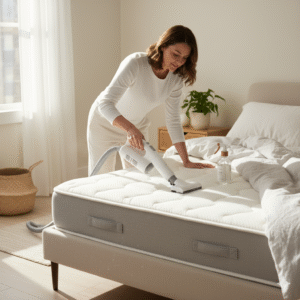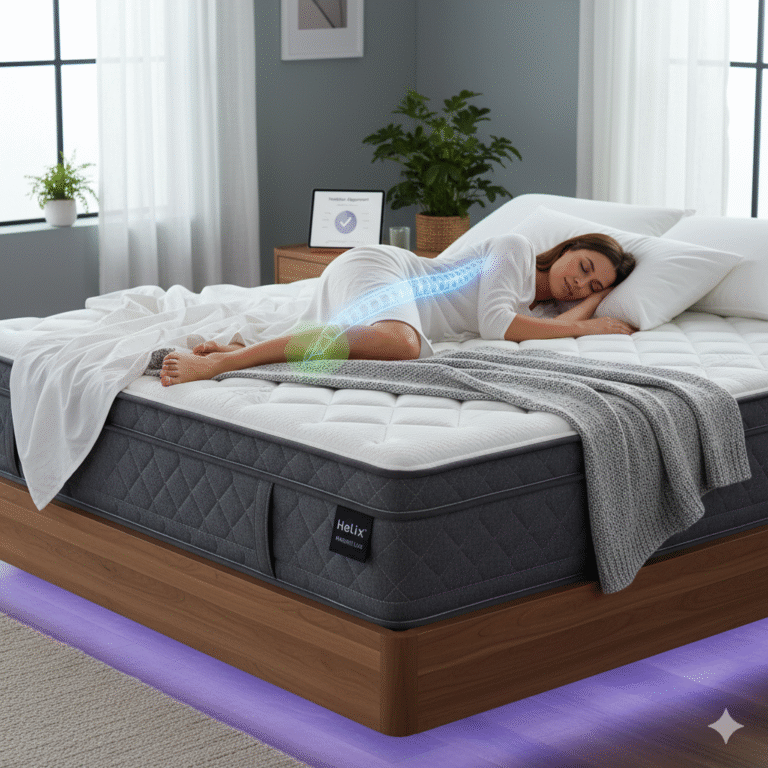Memory Foam Mattresses: The Perfect Balance of Comfort and Support
Quick answer: Memory foam mattresses excel at pressure relief and motion isolation for side sleepers, couples, and people with aches, but some sleepers may notice heat retention and a slow “sinking” feel—look for cooling foams and medium‑firm profiles to balance comfort and support.
Key Takeaways on Memory Foam Mattresses
- Best for pressure relief: Memory foam mattresses contour to reduce shoulder, hip, and back pain.
- Great for couples: Top‑tier motion isolation limits sleep disturbances.
- Watch heat: Choose gel‑infused or open‑cell foams and breathable covers if you sleep hot.
- Feel & firmness: A medium to medium‑firm memory foam mattress suits most side and back sleepers.
- Off‑gassing fades: Unbox in a ventilated room; smells usually dissipate within a few days.
- Sustainability & care: Use protective covers and good bedroom hygiene to extend mattress life.
Memory Foam Mattresses: Benefits, Drawbacks, and Best Uses
Here’s the gist: a memory foam mattress distributes weight evenly to relieve pressure points, absorbs motion to keep partners undisturbed, and adapts to your body for a custom feel.
Benefits of Memory Foam Mattresses
Answer first: The primary benefits are pressure relief, motion isolation, and customized contouring support. Unlike bouncy innersprings that can press into shoulders and hips, memory foam spreads load evenly to help minimize aches. Couples often prefer it because the foam absorbs movement, so a restless partner won’t wake you. And because it molds to your curves, many side sleepers and those with back or neck discomfort find it exceptionally comfortable.

Drawbacks of Memory Foam Mattresses
Answer first: The common trade‑offs are heat retention, a slower response that can feel “sinky,” and brief off‑gassing when new. If you sleep hot, prioritize modern cooling foams (gel, graphite, or open‑cell) and breathable covers. If you dislike being “hugged,” pick a firmer model or hybrid with a responsive transition layer. Any new‑mattress smell typically fades in a few days with ventilation.
Best Uses for Memory Foam Mattresses
Answer first: Memory foam shines for side sleepers, couples, and people managing chronic pain because of its contouring and motion control. For deeper sleep quality insights, see our guide on
sleep quality and memory.
If you’re optimizing your whole setup, pair your memory foam with a breathable protector and thoughtfully chosen bed frame ideas from our
global bed design roundup.
Smart Setup: Hygiene, Protection & Design
Answer first: Keep your memory foam mattress fresher for longer with preventative hygiene and a quality cover, and style your space for airflow and comfort.
Start with bedroom hygiene best practices from our guide to bed bug prevention and management, and consider why investing in a bed bug mattress cover is essential for protecting any new mattress. For frame and decor inspiration that promotes cozy airflow and layered comfort, explore Nordic bed design or take a historical detour with medieval bedding. Curious about materials? See our overview of
sustainable bed frame materials.
Buyer Tips: Getting the Feel Right
Answer first: Choose medium to medium‑firm for most sleepers, prioritize cooling if you run hot, and allow a 2–4 week break‑in period.
- Firmness: Side sleepers often like medium; back/combination sleepers may prefer medium‑firm.
- Cooling: Look for gel/open‑cell foams and breathable covers if you’re heat‑sensitive.
- Profile: Thicker comfort layers (2–4″) = deeper hug; thinner = flatter, easier movement.
- Trial & returns: Use the full trial window—your body may need time to adapt.
FAQ
Quick answers to common questions about memory foam mattresses.
- Do memory foam mattresses sleep hot?
- They can, but modern designs with gel or open‑cell foam plus breathable covers significantly reduce heat build‑up.
- How long does a memory foam mattress last?
- Quality models typically last 7–10 years with proper support and a protective cover.
- Is a memory foam mattress good for side sleepers?
- Yes—contouring relieves shoulder and hip pressure, which is why side sleepers often love memory foam.
- What about the “stuck” feeling?
- Choose a slightly firmer model or a hybrid with a responsive transition layer for easier repositioning.
- How do I reduce off‑gassing?
- Unbox in a ventilated room and wait 24–72 hours; most odors dissipate quickly.
Final Thoughts on Memory Foam Mattresses
If you’re considering a memory foam mattress,
weigh pressure relief and motion isolation against potential warmth and slow response. With today’s cooling tech and diverse firmness options, it’s easier than ever to find a memory foam mattress that adapts to your body and supports truly restorative sleep.






















